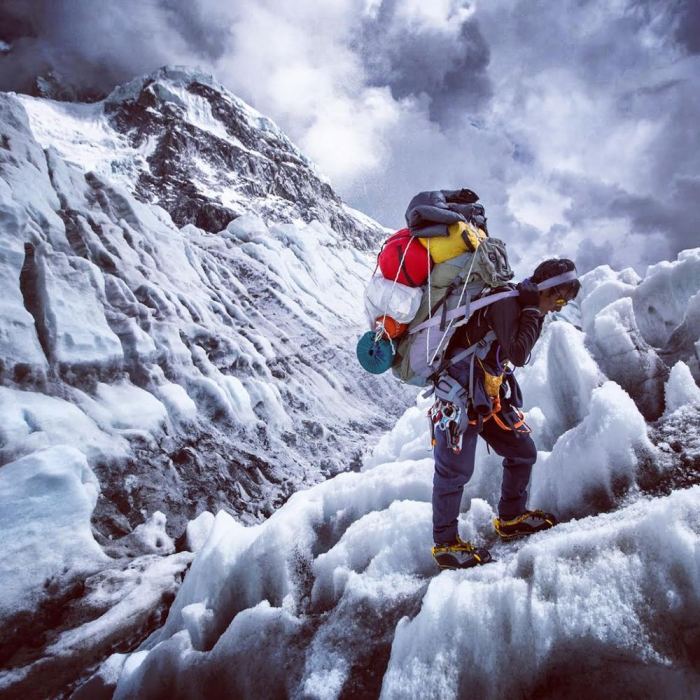Sherpa: the name conjures images of breathtaking Himalayan peaks and the indomitable spirit of the people who call them home. But beyond the iconic image of mountaineering guides, lies a rich tapestry of culture, history, and resilience. This deep dive explores the Sherpa people, from their ancient traditions and unique language to their pivotal role in mountaineering and the challenges they face in the modern world. We’ll uncover the stories behind their incredible strength, their enduring legacy, and their ongoing fight to preserve their heritage in the face of rapid change.
We’ll delve into the historical context of Sherpa involvement in mountaineering, examining both the incredible achievements and the ethical considerations surrounding their participation. We’ll also explore their vibrant artistic expressions, their evolving economic realities, and the impact of tourism on their communities. Get ready for a journey that’s as high-altitude as it is deeply human.
Modern Sherpa Life and Challenges
The iconic image of Sherpas guiding climbers up Everest’s slopes is just one facet of their lives. In the 21st century, Sherpas navigate a complex landscape of economic opportunities, environmental pressures, and the ongoing struggle to preserve their unique culture in the face of globalization. Their lives, once almost exclusively tied to the mountains, are increasingly diverse, reflecting both progress and persistent challenges.
Economic Opportunities and Challenges
The tourism industry, while providing significant income for many Sherpas, presents a double-edged sword. High-paying jobs as climbing guides and support staff exist, but these positions are often seasonal and highly competitive. The reliance on tourism also makes Sherpa livelihoods vulnerable to economic downturns, natural disasters (like avalanches or the impact of climate change), and global events (such as the pandemic). Beyond guiding, many Sherpas engage in businesses catering to tourists, such as running teahouses or offering trekking services. However, these ventures often face challenges related to infrastructure, access to capital, and competition. The lack of diversification in the economy leaves many Sherpas economically vulnerable.
Environmental Impacts of Tourism on Sherpa Communities
The influx of tourists has brought significant environmental consequences to the Sherpa homeland. Increased waste generation, pollution from vehicles and human activity, and the degradation of fragile ecosystems pose serious threats. Melting glaciers and changing weather patterns, exacerbated by climate change, directly impact traditional livelihoods like agriculture and yak herding. The increased pressure on resources also leads to deforestation and land degradation, further impacting the environment and the Sherpas’ way of life. For example, the increased demand for fuelwood in tourist areas leads to unsustainable deforestation practices.
Initiatives to Preserve Sherpa Culture and Traditions
Several initiatives aim to protect and promote Sherpa culture and traditions. These include community-based tourism projects that empower local communities and ensure that tourism benefits directly flow back into the region. Efforts to document and preserve Sherpa language, oral histories, and traditional arts are also underway. Educational programs focused on sustainable development and environmental awareness aim to equip the younger generation with the skills and knowledge to navigate the challenges of the modern world while preserving their cultural heritage. For instance, some organizations work to support the preservation of traditional Sherpa handicrafts and promote their sale through fair trade initiatives.
Comparison of Sherpa Living Conditions in Urban and Rural Areas
Sherpas living in urban areas, such as Kathmandu, often experience a higher cost of living and increased competition for jobs. While access to education and healthcare might be better, the cultural ties to their traditional way of life can weaken. In contrast, Sherpas in rural areas maintain closer connections to their cultural heritage but often face limited access to basic services like healthcare, education, and infrastructure. This disparity highlights the need for balanced development initiatives that cater to the specific needs of both urban and rural Sherpa communities.
Traditional vs. Modern Sherpa Livelihoods
| Traditional Livelihoods | Modern Occupations | Traditional Livelihoods | Modern Occupations |
|---|---|---|---|
| Yak herding | Mountain guide | Agriculture (potatoes, barley) | Teahouse owner |
| Trading (salt, wool) | Tourism-related businesses (hotels, trekking agencies) | Handicrafts (weaving, wood carving) | Government employment |
From the icy peaks of Everest to the bustling streets of Kathmandu, the Sherpa story is one of remarkable adaptation and enduring strength. Their contributions to mountaineering are undeniable, their culture a testament to resilience, and their future a complex interplay of tradition and modernity. Understanding the Sherpa people offers a window into the human spirit’s ability to not only survive but thrive in the face of immense challenges. Their journey continues, a testament to the power of community, the strength of heritage, and the enduring allure of the mountains.
 Invest Tekno Berita Teknologi Terbaru
Invest Tekno Berita Teknologi Terbaru
